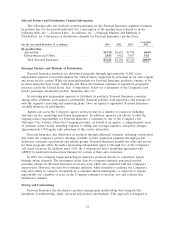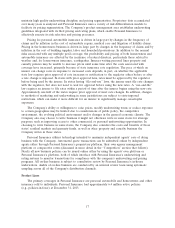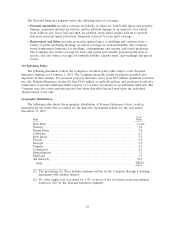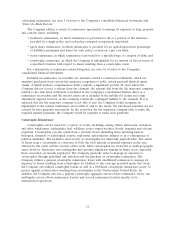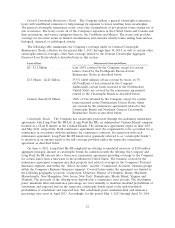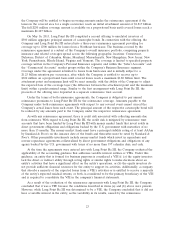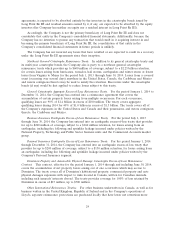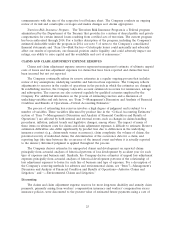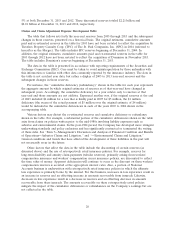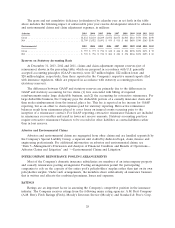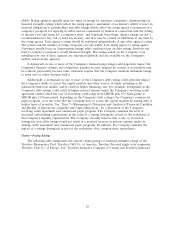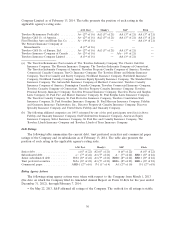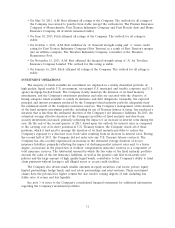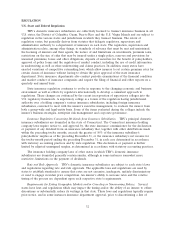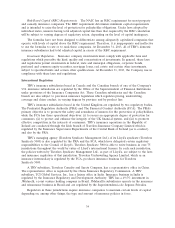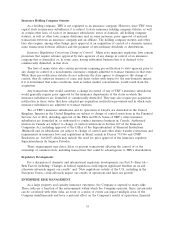Travelers 2013 Annual Report Download - page 36
Download and view the complete annual report
Please find page 36 of the 2013 Travelers annual report below. You can navigate through the pages in the report by either clicking on the pages listed below, or by using the keyword search tool below to find specific information within the annual report.5% at both December 31, 2013 and 2012. These discounted reserves totaled $2.21 billion and
$2.01 billion at December 31, 2013 and 2012, respectively.
Claims and Claim Adjustment Expense Development Table
The table that follows sets forth the year-end reserves from 2003 through 2013 and the subsequent
changes in those reserves, presented on a historical basis. The original estimates, cumulative amounts
paid and re-estimated reserves in the table for 2003 have not been restated to reflect the acquisition by
Travelers Property Casualty Corp. (TPC) of The St. Paul Companies, Inc. (SPC) in 2004 (referred to
hereafter as the Merger). The table includes SPC reserves beginning at December 31, 2004. In
addition, the original estimates, cumulative amounts paid and re-estimated reserves in the table for
2003 through 2012 have not been restated to reflect the acquisition of Dominion in November 2013.
The table includes Dominion’s reserves beginning at December 31, 2013.
The data in the table is presented in accordance with reporting requirements of the Securities and
Exchange Commission (SEC). Care must be taken to avoid misinterpretation by those unfamiliar with
this information or familiar with other data commonly reported by the insurance industry. The data in
the table is not accident year data, but rather a display of 2003 to 2013 year-end reserves and the
subsequent changes in those reserves.
For instance, the ‘‘cumulative deficiency (redundancy)’’ shown in the table for each year represents
the aggregate amount by which original estimates of reserves as of that year-end have changed in
subsequent years. Accordingly, the cumulative deficiency for a year relates only to reserves at that
year-end and those amounts are not additive. Expressed another way, if the original reserves at the end
of 2003 included $4 million for a loss that is finally paid in 2007 for $5 million, the $1 million
deficiency (the excess of the actual payment of $5 million over the original estimate of $4 million)
would be included in the cumulative deficiencies in each of the years 2003 to 2006 shown in the
accompanying table.
Various factors may distort the re-estimated reserves and cumulative deficiency or redundancy
shown in the table. For example, a substantial portion of the cumulative deficiencies shown in the table
arise from claims on policies written prior to the mid-1980s involving liability exposures such as
asbestos and environmental claims. In the post-1984 period, the Company has developed more stringent
underwriting standards and policy exclusions and has significantly contracted or terminated the writing
of these risks. See ‘‘Item 7—Management’s Discussion and Analysis of Financial Condition and Results
of Operations—Asbestos Claims and Litigation,’’ and ‘‘—Environmental Claims and Litigation.’’
General conditions and trends that have affected the development of these liabilities in the past will
not necessarily recur in the future.
Other factors that affect the data in the table include the discounting of certain reserves (as
discussed above) and the use of retrospectively rated insurance policies. For example, reserves for
long-term disability and annuity claim payments (tabular reserves), primarily arising from workers’
compensation insurance and workers’ compensation excess insurance policies, are discounted to reflect
the time value of money. Apparent deficiencies will continue to occur as the discount on these workers’
compensation reserves is accreted at the appropriate interest rates. Also, a portion of National
Accounts business is underwritten with retrospectively rated insurance policies in which the ultimate
loss experience is primarily borne by the insured. For this business, increases in loss experience result in
an increase in reserves and an offsetting increase in amounts recoverable from insureds. Likewise,
decreases in loss experience result in a decrease in reserves and an offsetting decrease in amounts
recoverable from these insureds. The amounts recoverable on these retrospectively rated policies
mitigate the impact of the cumulative deficiencies or redundancies on the Company’s earnings but are
not reflected in the table.
26


